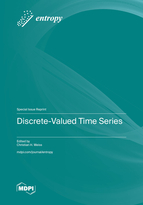Discrete-Valued Time Series
A special issue of Entropy (ISSN 1099-4300). This special issue belongs to the section "Information Theory, Probability and Statistics".
Deadline for manuscript submissions: closed (31 May 2023) | Viewed by 16536
Special Issue Editor
Interests: time series analysis; count time series; categorical time series; statistical process control; discrete data; computational statistics
Special Issues, Collections and Topics in MDPI journals
Special Issue Information
Dear Colleagues,
The first methods for analyzing time series were developed about 100 years ago. Since then, the field of time series analysis has enjoyed growing interest among researchers and practitioners. For most of this period, however, the focus was on real-valued time series, i.e., time series having a continuous range consisting of real numbers or real vectors. Starting slowly in the 1980s, and then rapidly since the 2000s, also discrete-valued time series began to attract more and more attention. Here, discrete-valued time series might be of various types. Undoubtedly most popular are count time series, the range of which is quantitative and consists of non-negative integers (either the full set of non-negative integers or a finite subset thereof with some specified upper bound). However, also truly integer-valued time series (where the range also includes negative integers) are increasingly considered. By contrast, categorical time series, with the range being qualitative, are still somewhat disregarded until now. Here, one has to distinguish the case where the attainable categories exhibit a natural ordering, so-called ordinal time series, and those where not even an ordering exists (nominal time series). Finally, we also sometimes end up with discrete-valued time series although the raw time series have a continuous range. Such discretizations happen, for example, if clipping is applied to a real-valued time series, or if methods based on ordinal patterns are used for its analysis.
All these (and possibly further) fields of time series analysis are covered by the intended Special Issue on "Discrete-valued Time Series". The aim is to bring together papers on:
- Stochastic models for discrete-valued time series of any type;
- Methods for analyzing discrete-valued or discretized time series (identification, estimation, validation, etc.);
- Univariate or multivariate discrete-valued or discretized time series;
- Applications of discrete time-series methods to forecasting, change-point detection, or statistical process control (among others).
Papers including real applications, and maybe covering historical aspects of discrete-valued time series analysis, are particularly welcome. The Special Issue is also open to interdisciplinary research or comprehensive survey papers (also aspects of teaching or software might be touched upon), as long as methods or models for discrete-valued or discretized time series constitute the core of the contribution.
Prof. Dr. Christian H. Weiss
Guest Editor
Manuscript Submission Information
Manuscripts should be submitted online at www.mdpi.com by registering and logging in to this website. Once you are registered, click here to go to the submission form. Manuscripts can be submitted until the deadline. All submissions that pass pre-check are peer-reviewed. Accepted papers will be published continuously in the journal (as soon as accepted) and will be listed together on the special issue website. Research articles, review articles as well as short communications are invited. For planned papers, a title and short abstract (about 100 words) can be sent to the Editorial Office for announcement on this website.
Submitted manuscripts should not have been published previously, nor be under consideration for publication elsewhere (except conference proceedings papers). All manuscripts are thoroughly refereed through a single-blind peer-review process. A guide for authors and other relevant information for submission of manuscripts is available on the Instructions for Authors page. Entropy is an international peer-reviewed open access monthly journal published by MDPI.
Please visit the Instructions for Authors page before submitting a manuscript. The Article Processing Charge (APC) for publication in this open access journal is 2600 CHF (Swiss Francs). Submitted papers should be well formatted and use good English. Authors may use MDPI's English editing service prior to publication or during author revisions.







